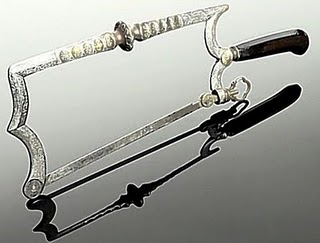 Lithotome (1740s-1830s)
Lithotome (1740s-1830s) Knife in 1900s
Knife in 1900s
Hysterotome 1860-90

































Mouth Gag 1880s-1910

Hernia Tool 1850's

Hemorrhoid Forcep 1800s

Ecraseur 1870's

Circumcition Knife 1770's

Hirtz compass 1915

Bullet Extractor 1500s

Artificial Leech 1800's

Arrow Remover 1500's

Amputation Saw 1600's

Cervical Dilator 1800's

The great aspect of being certified in this field is that there is not going to be a problem finding a position and many are going to have many offers. colleges for surgical technologist
ReplyDeleteTreating diabetes naturally is associated to eating healthy food, controlling body weight, and avoiding foods increasing blood sugar in the blood stream. mcdonald's diabetic options
ReplyDeleteCertified nursing assistants are needed more and more with each passing day and it is no wonder that people are turning to training to become such and fill the open gaps in hospital, homes and clinics. Online cna program California
ReplyDeleteImagine if a child had the ability to control how they deal with important challenges. With a simple training, a child can develop habits that allow them to control these life skills with a simple word or phrase. what can a diabetic eat at zaxby's
ReplyDeleteAlthough alternative (complementary) medicine is still battling to make its approaches available to the masses, in some countries of the world such as Australia, Germany, England, New Zealand and now also in the United States. rorer 714 pill
ReplyDelete